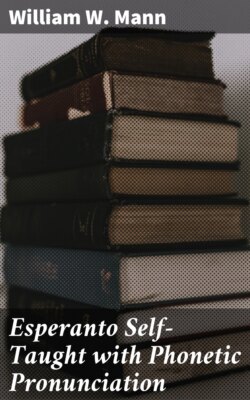Читать книгу Esperanto Self-Taught with Phonetic Pronunciation - William W. Mann - Страница 4
На сайте Литреса книга снята с продажи.
THE ESPERANTO ALPHABET
(WITH PHONETIC PRONUNCIATION).
ОглавлениеTable of Contents
The Esperanto Alphabet has 28 letters—23 consonants, 5 vowels:—
| Characters. | Name and English Pronunciation. | Phonetics used. |
|---|---|---|
| A, a | (ah) like a in father or pa; as patro (pah'troh). In unaccented syllables it should not be dwelt upon, and in all cases it should be pronounced quite purely, without the slight drawling r-sound which is sometimes added to the corresponding vowel in English | ah |
| B, b | (bo) as in English | b |
| C, c | (tsoh) like ts in gets, hits, and never as in English; as caro (tsah'roh) | ts |
| Ĉ, ĉ | (cho) like ch in church; as ĉasi (chah'see) | ch |
| D, d | (do) as in English, but with tip of tongue placed on back of teeth instead of on front ridge of roof of mouth | d |
| E, e | (eh) like e in bend pronounced broadly, or a in hate shortly pronounced, but quite pure, entirely without the slight drawling ee-sound often heard after the English vowel; as beno (beh'noh) | e, eh |
| F, f | (fo) as in English | f |
| G, g | (go) like g in go, give, as gasto (gah'stoh), and never like g in gem, allege | g |
| Ĝ, ĝ | (jo) like g in gem, general, and j in jovial; as ĝeni (jeh'nee) | j |
| H, h | (ho) as in English | h |
| Ĥ, ĥ | (ĥo) like ch in Scotch loch, ch in German hoch, j in Spanish mujer. This guttural sound is practically a very strongly aspirated h, and may be made by trying to pronounce "ho" with the throat arranged as for saying k:—ĥoro (khoro), ĥino (khino) | kh |
| I, i | (ee) like ee in seen, as li (lee). In unaccented syllables, and before two consonants together, this i practically becomes the i in it or in wind; as ferminte (fehrr-min'teh) | ee, i |
| J, j | (yo) always like y in yet, as jes (yehss), vojo (vo'yo), and never like j in judge, joke | y |
| It should be remembered that j is always a consonant, with the sound of the English y in you. Of course, when j occurs at the end of a word or before a consonant, it practically unites with the preceding vowel to form a diphthong, and loses the full consonantal sound which it has before a vowel. Thus: | ||
| Aj (ahy), like ah y in ah yes (almost like y in my); as kaj (kah'y), rajdi (rah'y-dee), krajono (krah-yo'no) | ahy | |
| Ej (ehy), like ay y in say yes; as plej (pleh'y, one syllable) | ehy | |
| Oj (oy), like oh y in oh yes (almost like oy in toy); as ranoj (rah'noy), kojno (koy'noh) | oy | |
| Uj (ooy), like oo y in too young; as tuj (too'y, one syllable), prujno (proo'yno, two syllables) | ooy | |
| Ĵ, ĵ | (zho) like s in vision or pleasure, or j in French jeune, j'ai; as ĵeti (zheh'tee) | zh |
| K, k | (ko) as in English | k |
| L, l | (lo) as in English | l |
| M, m | (mo) as in English | m |
| N, n | (no) as in English | n |
| O, o | (oh) like o in horse, not diphthongized, but pronounced purely and rather shortly, as bona (boh'nah NOT bow'nah), quite without the short oo-sound frequently heard with the English vowel in such words as note, boat. Its sound is almost equivalent to aw in caw, pronounced shortly and with the lips placed roundly as if for saying oh; as estonta (ess-tohn'tah) | o, oh |
| P, p | (po) as in English | p |
| R, r | (ro) as in English, but sounded much more forcibly, and always with a trill as in singing; as korpo (kohr'po) | r |
| S, s | (so) like s in say, as suno (soo'noh), and never as s in rose; as pesi (peh'see) | s, ss |
| Ŝ, ŝ | (sho) like sh in show, she; as ŝipo (shee'poh) | sh |
| T, t | (to) as in English, but dentally—with tip of tongue placed on back of teeth instead of on front ridge of roof of mouth | t |
| U, u | (oo) like oo in boot, as nubo (noo'boh); and never as u in mute or but | oo |
| Ŭ, ŭ | (wo) is equivalent to the English w, and is produced by a partial bringing together of the lips. It practically only occurs after a or e | w, ŏŏ |
| (1) Aŭ. To say antaŭ, for instance, say "ahn'tah," and finish by bringing the lips slightly together to pronounce the ŭ (w). Similarly for laŭta (lah'w-tah). This sound is not exactly the English ou in house, but is just the au in the German Haus. The phonetic sign for aŭ, therefore is | ahw | |
| (2) Eŭ, as in Eŭropo (ehw-ro'poh), is pronounced with a similar closing of the lips after the eh-sound | ehw | |
| V, v | (vo) as in English | v |
| Z, z | (zo) as in English | z |
